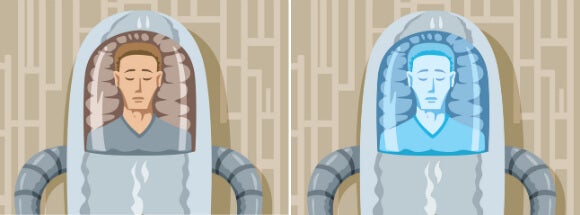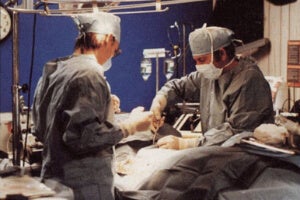Suspended Animation Goes Primetime: Say Goodbye To Death As We Know It

Share

Death has always been something of a moving target. Take, for example, the first edition of the Encyclopedia Britannica, published in 1768, that defined the term as “the separation of soul and body; in which sense it stands opposed to life, which consists in the union thereof.
But how can you tell when said separation occurs? Well, that’s a slightly more complicated procedure and one we still haven’t quite cracked. Thus, moving forward, and trying for an—um— more practical definition, we began to define the end of life by a series of cessations.
In the beginning, breath was life. Of course, this idea led to the obvious reversal, the cessation of breath, meant the cessation of life. But that didn’t last for long.
As our knowledge of biology improved, death became definable by the cessation of heart function. In other words, if you were out of pulse, you were out of time.
But advances in neuroscience, ideas about brain death, and the introduction of mechanical ventilators—with their ability to keep the heart pumping long after the brain had died—forced a society-wide reevaluation of terms.
At issue were irreversible comas and the tricky legalities of organ harvesting (i.e. when is someone dead enough that we can borrow their kidneys to give to someone more alive and in need, but not too dead that those kidneys stop working). And it was just this issue that brought together an ad hoc committee at Harvard Medical School in 1968. In an effort to come up with a hard and practical definition of “irreversible coma,” the committee also established “brain death” as the best proof of life’s end.
The Harvard criteria spread from there, effectively becoming the accepted definition the world over. But once again, not so fast.
Back in 2002, researchers at the University of Michigan Hospital in Ann Arbor announced that they had—using pigs—found a way to remove all of the animal’s blood and replace it with cold saline solution, which induces rapid hypothermia and halts almost all cellular activity—essentially placing the pig into suspended animation.
Once again, our technology messed with our terminology. “After we did those experiments,” Peter Rhee, one of the main researchers involved, recently told New Scientist, “the definition of ‘dead’ changed. Every day at work I declare people dead. They have no signs of life, no heartbeat, no brain activity. I sign a piece of paper knowing in my heart that they are not actually dead. I could, right then and there, suspend them. But I have to put them in a body bag. It’s frustrating to know there is a solution.”
Be Part of the Future
Sign up to receive top stories about groundbreaking technologies and visionary thinkers from SingularityHub.


And that solution is finally being tested out in humans. As of March 29, 2014, a team of surgeons trained in this saline-cooling procedure is on emergency call at the UPMC Presbyterian Hospital in Pittsburgh, Pennsylvania. In this field trial of the technique, patients who arrive at the hospital after having suffered cardiac arrest after traumatic injury (i.e. gunshots) and do not respond to attempts to restart their heart will be cooled with saline to about 10 degrees Celsius (50 Fahrenheit). Their cellular activity will stop. They will be “clinically dead.” But—if doctors can repair the trauma in roughly two hours—they are still capable of being revived.
In itself, this is amazing. This is two hours of suspended animation—which has been the stuff of sci-fi for almost a century. Today it’s scientific fact.
But where things get really interesting is what happens tomorrow. As the technology progresses, it is not too much of a stretch to say those two hours of suspended animation will give way to four hours and eight hours and sooner or later whole days and weeks and months—in other words, we’ll have mastered artificial hibernation.
And there are plenty of good reasons to master this technique, with deep space exploration being at the top of most people’s lists. But what happens, say, when a spaceship on its way to the planet formerly known as Pluto, complete with a crew in hibernation, gets dinged by an asteroid and knocked off course and is thus lost before they land and can be reanimated. The crew spends years and years and years in artificial hibernation. So are they alive or are they dead?
Put differently, if we know this crew can be later revived, but centuries might pass before we can actually catch the ship and revive the crew, is it ethical for us to shoot up a death ray laser beam from Earth to destroy ship and put the crew out of their suspended misery?
Since that 1768 Encyclopedia Britannica definition, the entry for death has been rewritten over 30 times. You would assume that today, in a society that can measure effects down to the quantum level, that death’s definition would be fixed. But with suspended animation suddenly heading into human trails, when it comes to defining death, we’re still nowhere close to a straight answer.
[images: cryogenics courtesy of Shutterstock; induced hibernation/wikipedia]
Steven Kotler is a New York Times bestselling author and founder and executive director at the Flow Research Collective. His books include: Stealing Fire, the Rise of Superman, Abundance, Bold, West of Jesus, A Small Furry Prayer, among many others. His work has been translated into over 40 languages and appeared in over 100 publications, including The New York Times Magazine, The Wall Street Journal, TIME, Atlantic Monthly, and Forbes. You can find him online at: www.stevenkotler.com
Related Articles

This Light-Powered AI Chip Is 100x Faster Than a Top Nvidia GPU

This Week’s Awesome Tech Stories From Around the Web (Through December 20)

Data Centers in Space: Will 2027 Really Be the Year AI Goes to Orbit?
What we’re reading
